Heading for the Ocean
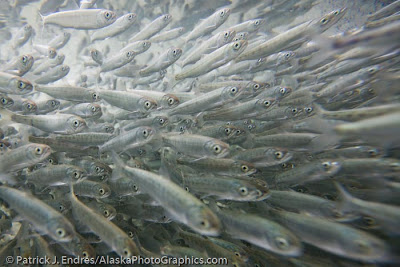 Sockeye salmon smolt head for the salt water after feeding and growing in Summit lake for one year.
Sockeye salmon smolt head for the salt water after feeding and growing in Summit lake for one year.
This is part two of a lengthy photo series I’ll be doing through the summer and autumn, focusing on the Gulkana hatchery and its role in enhancing the Copper river Sockeye salmon that migrate its waters. Click here for part one.
The life span of a Sockeye salmon is four to five years. Eggs are laid in fresh water streams/lakes in late summer/autumn where they incubate over the winter and hatch in the spring. The little fry spend a year feeding and growing in the lakes and as soon as the ice melts in late spring the one year old salmon (smolt) head for the salt water. This outmigration process takes place in the darker hours of the night over the course of a few weeks/months, depending on the lake (usually ending around the fourth of July says hatchery manager Gary Martinek). Why in dark hours? Well, there are a lot of creatures hungry for these shiny little fish. Predators such as lake trout, terns and gulls take a heavy toll on the fish.
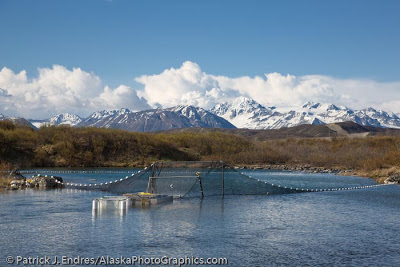
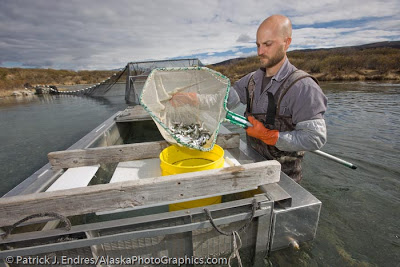 About the only way to track fry survivorship in the lake is to approximate how many make it out as smolt. The Hatchery sets up a trap at the mouth of the lake to do just that, and through a measurement regime calculates the total number of out-migrating smolt.
About the only way to track fry survivorship in the lake is to approximate how many make it out as smolt. The Hatchery sets up a trap at the mouth of the lake to do just that, and through a measurement regime calculates the total number of out-migrating smolt.
These little fish vary in color when viewed from the top, but if you get a glance at their sides, they are a flash of silver! It’s amazing that a 3 to 4 inch fish can make it all the way down the river to the Pacific Ocean, but nature is loaded with mysteries, and the migrating salmon is one of the big ones. For those that reach the salty waters, they will feed for three or four years, and return again to the waters of their youth to spawn their successors. The next few chapters of this story will focus on the consumers of these fish, like me and my friends, fishermen, and others who tap into this great food source.
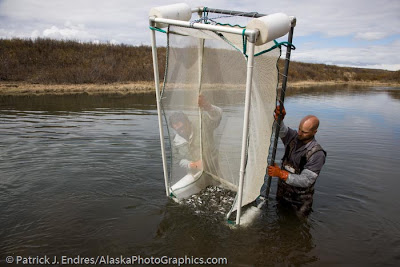 Smolt caught in the outmigration nets are counted and released to continue their way down the Gulkana river, to the Copper river, out into the Pacific Ocean.
Smolt caught in the outmigration nets are counted and released to continue their way down the Gulkana river, to the Copper river, out into the Pacific Ocean.
Notes on the Underwater Photo:
First of all, thanks to the Gulkana Hatchery guys for keeping some of the smolt in a pen for me to work with.
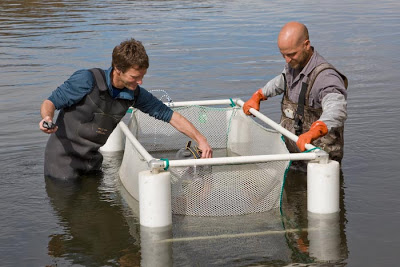 Yours truly using a wireless transmitter and underwater housing to photograph the smolt.
Yours truly using a wireless transmitter and underwater housing to photograph the smolt.
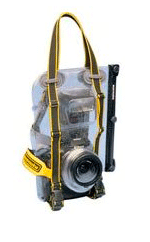 Attached to the top of the camera inside the housing is a wireless reciever (Pocket Wizard) that enables me to trigger the shutter remotely from a hand held transmitter. Since the little salmon fry are pretty skittish, you can’t have your hands in the water or they get freaked out. I set the camera on AV priority–the light was changing quite a bit with sun and clouds–and pre focused the lens to the closest focus distance. From there it is experimentation. I increased the depth of field in subsequent photos, but I like the positioning of the fish in this frame the best.
Attached to the top of the camera inside the housing is a wireless reciever (Pocket Wizard) that enables me to trigger the shutter remotely from a hand held transmitter. Since the little salmon fry are pretty skittish, you can’t have your hands in the water or they get freaked out. I set the camera on AV priority–the light was changing quite a bit with sun and clouds–and pre focused the lens to the closest focus distance. From there it is experimentation. I increased the depth of field in subsequent photos, but I like the positioning of the fish in this frame the best.
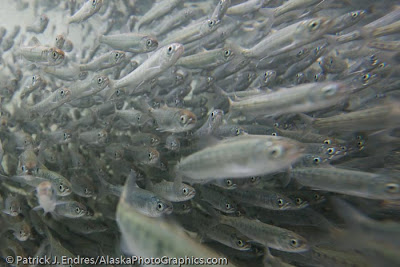 Canon 1Ds Mark III, 16-35mm 2.8L, Ewa-marine underwater housing, 1/2000 sec @f4.5, ISO 1000.
Canon 1Ds Mark III, 16-35mm 2.8L, Ewa-marine underwater housing, 1/2000 sec @f4.5, ISO 1000.






